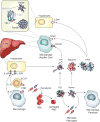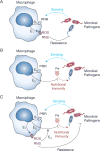Innate Nutritional Immunity
- PMID: 29914937
- PMCID: PMC6028930
- DOI: 10.4049/jimmunol.1800325
Innate Nutritional Immunity
Abstract
Iron (Fe) is an essential micronutrient for both microbes and their hosts. The biologic importance of Fe derives from its inherent ability to act as a universal redox catalyst, co-opted in a variety of biochemical processes critical to maintain life. Animals evolved several mechanisms to retain and limit Fe availability to pathogenic microbes, a resistance mechanism termed "nutritional immunity." Likewise, pathogenic microbes coevolved to deploy diverse and efficient mechanisms to acquire Fe from their hosts and in doing so overcome nutritional immunity. In this review, we discuss how the innate immune system regulates Fe metabolism to withhold Fe from pathogenic microbes and how strategies used by pathogens to acquire Fe circumvent these resistance mechanisms.
Copyright © 2018 by The American Association of Immunologists, Inc.
Conflict of interest statement
The authors have no conflicting financial interests.
Figures



Similar articles
-
Iron in infection and immunity.Cell Host Microbe. 2013 May 15;13(5):509-519. doi: 10.1016/j.chom.2013.04.010. Cell Host Microbe. 2013. PMID: 23684303 Free PMC article. Review.
-
Iron Metabolism and the Inflammatory Response.IUBMB Life. 2017 Jun;69(6):442-450. doi: 10.1002/iub.1635. Epub 2017 May 5. IUBMB Life. 2017. PMID: 28474474 Review.
-
Iron and innate antimicrobial immunity-Depriving the pathogen, defending the host.J Trace Elem Med Biol. 2018 Jul;48:118-133. doi: 10.1016/j.jtemb.2018.03.007. Epub 2018 Mar 10. J Trace Elem Med Biol. 2018. PMID: 29773170 Review.
-
Ironing out the wrinkles in host defense: interactions between iron homeostasis and innate immunity.J Innate Immun. 2009;1(5):455-64. doi: 10.1159/000210016. Epub 2009 Mar 23. J Innate Immun. 2009. PMID: 20375603 Free PMC article. Review.
-
War-Fe-re: iron at the core of fungal virulence and host immunity.Biometals. 2011 Jun;24(3):547-58. doi: 10.1007/s10534-011-9431-8. Epub 2011 Mar 13. Biometals. 2011. PMID: 21399939 Review.
Cited by
-
The "Little Iron Waltz": The Ternary Response of Paracoccidioides spp. to Iron Deprivation.J Fungi (Basel). 2020 Oct 12;6(4):221. doi: 10.3390/jof6040221. J Fungi (Basel). 2020. PMID: 33053811 Free PMC article. Review.
-
Gut Microbiota and Iron: The Crucial Actors in Health and Disease.Pharmaceuticals (Basel). 2018 Oct 5;11(4):98. doi: 10.3390/ph11040098. Pharmaceuticals (Basel). 2018. PMID: 30301142 Free PMC article. Review.
-
The Importance of Iron Status for Young Children in Low- and Middle-Income Countries: A Narrative Review.Pharmaceuticals (Basel). 2019 Apr 16;12(2):59. doi: 10.3390/ph12020059. Pharmaceuticals (Basel). 2019. PMID: 30995720 Free PMC article. Review.
-
A Cytoplasmic Heme Sensor Illuminates the Impacts of Mitochondrial and Vacuolar Functions and Oxidative Stress on Heme-Iron Homeostasis in Cryptococcus neoformans.mBio. 2020 Jul 28;11(4):e00986-20. doi: 10.1128/mBio.00986-20. mBio. 2020. PMID: 32723917 Free PMC article.
-
Transferrin Receptor 1-Associated Iron Accumulation and Oxidative Stress Provides a Way for Grass Carp to Fight against Reovirus Infection.Int J Mol Sci. 2019 Nov 22;20(23):5857. doi: 10.3390/ijms20235857. Int J Mol Sci. 2019. PMID: 31766619 Free PMC article.
References
-
- Chapman SK, Daff S, Munro AW. Heme: The most versatile redox centre in biology? Metal Sites in Proteins and Models. 1997;88:39–70.
-
- Verbon EH, Trapet PL, Stringlis IA, Kruijs S, Bakker P, Pieterse CMJ. Iron and Immunity. Annu Rev Phytopathol. 2017;55:355–375. - PubMed
Publication types
MeSH terms
Substances
Grants and funding
LinkOut - more resources
Full Text Sources
Other Literature Sources
Medical

